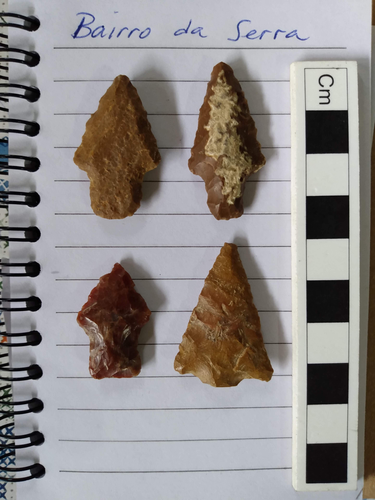Review: 1

The Physics and Metaphysics of Classification in Archaeology
The “Beast Within” – Querying the (Cultural Evolutionary) Status of Types in Archaeology
Recommended by Shumon Tobias Hussain, Felix Riede and Sébastien Plutniak based on reviews by Edward B. Banning and 2 anonymous reviewers“On the Physics and Metaphysics of Classification in Archaeology” by M. Okumura and A.G.M. Araujo (1) is a welcome contribution to our upcoming edited volume on type-thinking and the uses and misuses of archaeological typologies. Questions of type-delineation and classification of archaeological materials have recently re-emerged as key arenas of scholarly attention and interrogation (2–4), as many researchers have turned to a matured field of cultural evolutionary studies (5–7) and as fine-grained archaeological data and novel computational-quantitative methods have becomes increasingly available in recent years (8, 9). Re-assessing the utility and significance of traditional archaeological types has also become pertinent as macro-scale approaches to the past have grown progressive to the centre of the discipline (10, 11), promising not only to ‘re-do’ typology ‘from the ground up’, but also to put types and typological systems to novel and powerful use, and in the process illuminate the many understudied large-scale dynamics of human cultural evolution which are so critical to understanding our species’ venture on this planet. As such, the promise is colossal yet it requires a solid analytical base, as many have insisted (e.g., 12). Types are often identified as such foundational analytical units, and much therefore hinges on the robust identification and differentiation of types within the archaeological record. Typo-praxis – the practice of delineating and constructing types and to harness them to learn about the archaeological record – is therefore also increasingly seen as a key ingredient of what Hussain and Soressi (13) have dubbed the ‘basic science’ claim of lithic research within human origins or broader (deep-time) evolutionary studies.
The stakes are accordingly incredibly high, yet as Okumura and Araujo point out there is still no need to ‘re-invent the wheel’ as there is a rich literature on classification and systematics in the biological sciences, from which archaeologists can draw and benefit. Some of this literature was indeed already referenced by some archaeologists between the 1960s and early 2000s when first attempts were undertaken to integrate Darwinian evolutionary theory into processual archaeological practice (14, 15). It may be argued that much of this literature and its insights – including its many conceptual and terminological clarifications – have been forgotten or sidelined in archaeology primarily because the field has witnessed a pronounced ‘cultural turn’ beginning in the early 2000s, with even processualists expanding their research portfolio to include what was previously considered post-processual terrain (16, 17). Michelle Hegmon’s (16) ‘processualism plus’ was perhaps the most emphatic expression of this trajectory within the influential Anglo-American segments of the profession. Okumura and Araujo are therefore to be applauded for their attempt to draw attention again to this literature in an effort to re-activate it for contemporary research efforts at the intersection of cultural evolutionary and computational archaeology. Decisions need to be made on the way, of course, and the authors defend a theory-guided (and largely theory-driven) approach, for example insisting on the importance of understanding the metaphysical status of types as arbitrary kinds. Their chapter is hence also a contribution (some may say intervention) to the long-standing tension between the tyranny of data vs. the tyranny of theory in type-construction. They clearly take side with those who argue that typo-praxis cannot evade its metaphysical nature – i.e., it will always be concerned (to some extent at least) with uncovering basic metaphysical principles of the world, even if the link between types and world is not understood as a simple mapping function. Carving the investigated archaeological realities ‘at their joints’ remains an overarching ambition from this perspective. Following Okumura and Araujo, archaeologists interested in these matters therefore cannot avoid to become part-time metaphysicians.
Okumura and Araujo’s contribution is timely and it brings key issues of debate to archaeological attention, and many of these issues tellingly overlap substantially with foundational debates in the philosophy of science (e.g. monism vs. pluralism, essentialism vs. functionalism, and so forth). Their chapter also showcases how critical (both in an enabling and limiting way) biological metaphors such as ‘species’ are (see esp. the discussion of ‘species as sets’ vs. ‘species as individuals’) for their and cognate projects. Whether such metaphors are justified in the context of human action is a longstanding point of contention, and other archaeologies – for example those with decidedly relational, ontological, and post-humanist aspirations – have developed very different optics (see e.g. 18, esp. Chapter 6). This being said, Okumura and Araujo’s contribution will be essential for those interested in (re-)learning about the ‘physics and metaphysics’ of archaeological classification and their chapter will be an excellent place to start with such engagement.
References
1. M. Okumura and A. G. M. Araujo (2024) The Physics and Metaphysics of Classification in Archaeology. Zenodo, ver.3 peer-reviewed and recommended by PCI Archaeology https://doi.org/10.5281/zenodo.7515797
2. F. Riede (2017) “The ‘Bromme problem’ – notes on understanding the Federmessergruppen and Bromme culture occupation in southern Scandinavia during the Allerød and early Younger Dryas chronozones” in Problems in Palaeolithic and Mesolithic Research, pp. 61–85.
3. N. Reynolds and F. Riede (2019) House of cards: cultural taxonomy and the study of the European Upper Palaeolithic. Antiquity 93, 1350–1358. https://doi.org/10.15184/aqy.2019.49
4. R. L. Lyman (2021) On the Importance of Systematics to Archaeological Research: the Covariation of Typological Diversity and Morphological Disparity. J Paleo Arch 4, 3. https://doi.org/10.1007/s41982-021-00077-6
5. A. Mesoudi (2011) Cultural Evolution: How Darwinian Theory Can Explain Human Culture and Synthesize the Social Sciences, University of Chicago Press. https://doi.org/10.7208/9780226520452
6. N. Creanza, O. Kolodny and M. W. Feldman (2017) Cultural evolutionary theory: How culture evolves and why it matters. Proceedings of the National Academy of Sciences 114, 7782–7789. https://doi.org/10.1073/pnas.1620732114
7. R. Boyd and P. J. Richerson (2024) Cultural evolution: Where we have been and where we are going (maybe). Proceedings of the National Academy of Sciences 121, e2322879121. https://doi.org/10.1073/pnas.2322879121
8. F. Riede, D. N. Matzig, M. Biard, P. Crombé, J. F.-L. de Pablo, F. Fontana, D. Groß, T. Hess, M. Langlais, L. Mevel, W. Mills, M. Moník, N. Naudinot, C. Posch, T. Rimkus, D. Stefański, H. Vandendriessche and S. T. Hussain (2024) A quantitative analysis of Final Palaeolithic/earliest Mesolithic cultural taxonomy and evolution in Europe. PLOS ONE 19, e0299512, https://doi.org/10.1371/journal.pone.0299512
9. L. Fogarty, A. Kandler, N. Creanza and M. W. Feldman (2024) Half a century of quantitative cultural evolution. Proceedings of the National Academy of Sciences 121, e2418106121. https://doi.org/10.1073/pnas.2418106121
10. A. M. Prentiss, M. J. Walsh, E. Gjesfjeld, M. Denis and T. A. Foor (2022) Cultural macroevolution in the middle to late Holocene Arctic of east Siberia and north America. Journal of Anthropological Archaeology 65, 101388. https://doi.org/10.1016/j.jaa.2021.101388
11. C. Perreault (2023) Guest Editorial. Antiquity 97, 1369–1380.
12. F. Riede, C. Hoggard and S. Shennan (2019) Reconciling material cultures in archaeology with genetic data requires robust cultural evolutionary taxonomies. Palgrave Commun 5, 1–9. https://doi.org/10.1057/s41599-019-0260-7
13. S. T. Hussain and M. Soressi (2021) The Technological Condition of Human Evolution: Lithic Studies as Basic Science. J Paleo Arch 4, 25. https://doi.org/10.1007/s41982-021-00098-1
14. R. C. Dunnell (1978) Style and Function: A Fundamental Dichotomy. American Antiquity 43, 192–202.
15. R. C. Dunnell (2002) Systematics in Prehistory, Illustrated Edition, The Blackburn Press.
16. M. Hegmon (2003) Setting Theoretical Egos Aside: Issues and Theory in North American Archaeology. American Antiquity 68, 213–243. https://doi.org/10.2307/3557078
17. R. Torrence (2001) “Hunter-gatherer technology: macro- and microscale approaches” in Hunter-Gatherers: An Interdisciplinary Perspective, Cambridge University Press.
18. C. N. Cipolla, R. Crellin and O. J. T. Harris (2024) Archaeology for today and tomorrow, Routledge.

